Motion Correction: Clear Your Head
Oral
Acquisition, Reconstruction & Analysis
Thursday, 21 June 2018
| S05 |
13:15 - 15:15 |
Moderators: Maxim Zaitsev, Daniel Gallichan |
13:15
|
1167.
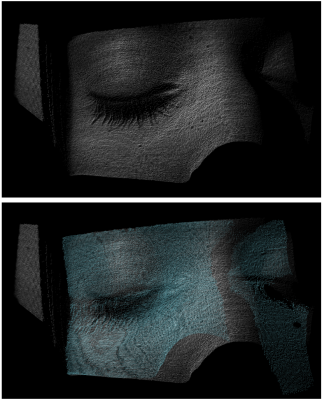 |
 Markerless real-time motion correction for T1- and T2-weighted neuroanatomical MRI Markerless real-time motion correction for T1- and T2-weighted neuroanatomical MRI
Robert Frost, Paul Wighton, Isik Karahanoglu, Richard Robertson, P. Grant, Bruce Fischl, M. Tisdall, Andre van der Kouwe
This study investigates real-time head motion correction using markerless tracking of the subject's face to mitigate the major problems caused by patient movement in clinical and research MRI. The effects of motion include repeat scanning, impaired clinical diagnosis, need for sedation or anesthesia, and biased research results. Markerless tracking and correction is appealing because it could offer minimal disruption to the MRI workflow, sequence independence, and high-frequency motion estimation. Real-time correction substantially improved T2-SPACE and MPRAGE image quality in scans with intentional motion, compared to uncorrected scans. Cortical surface reconstructions, brain structure volumes, and cortical thickness estimated from the motion-corrected MPRAGE scan showed good correspondence with the gold standard scans without intentional movement. Markerless real-time correction is a promising approach to reduce the effects of motion in neuro MRI.
|
13:27
|
1168.
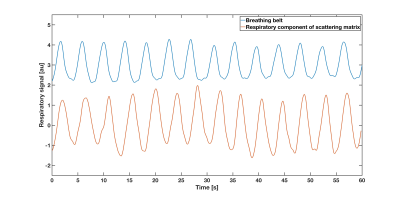 |
 Simultaneous detection of cardiac, respiratory, and rigid body head motion using the scattering of a parallel transmit RF coil at 7T Simultaneous detection of cardiac, respiratory, and rigid body head motion using the scattering of a parallel transmit RF coil at 7T
Daniel Papp, Sven Jaeschke, Sebastian Rieger, Stuart Clare, Aaron Hess
Cardiac pulsation, respiration and rigid-body head motion induce changes in relative tissue conductivity. These changes can be detected via the scattering of a parallel transmit RF coil array at 7T, by monitoring the forward and reflected power of each channel, with a 5ms pulse. The time series of the scattering data can be used to detect cardiac and respiratory motion, as well as predict head position using training data. We show that detected heart and respiration rates match those recorded with independent monitoring, and head position may be predicted with reasonable precision, at little extra time cost.
|
13:39
 |
1169.
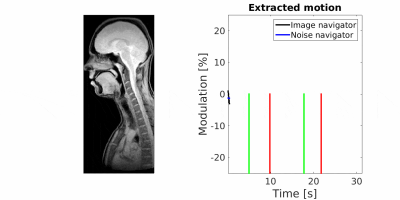 |
 Noise navigator based motion detection and compensation Noise navigator based motion detection and compensation
Robin Navest, Tom Bruijnen, Jan Lagendijk, Anna Andreychenko, Cornelis van den Berg
The feasibility of irregular and unpredictable motion detection and retrospective head motion artifact removal was demonstrated based on the noise navigator. The key advantages of the noise navigator are its inherent synchronization with MR acquisition, compatibility with most read-out strategies and no additional acquisition or hardware is required. Only the raw k-space data needs to be available for this method.
|
13:51
 |
1170.
 |
 Prospective Motion Correction in Multiband fMRI Using Multislice-to-Volume Image Registration Prospective Motion Correction in Multiband fMRI Using Multislice-to-Volume Image Registration
Daniel Hoinkiss, Peter Erhard, Matthias Günther, Nora-Josefin Breutigam, Federico von Samson-Himmelstjerna, David Porter
This study introduces an image-based technique for prospective motion correction in multiband fMRI utilizing multislice-to-volume image registration. Motion detection is based on a single multiband excitation and readout, which allows a high temporal resolution and does not depend on the repetition time or the total number of slices. Results show high accuracy in correcting involuntary as well as intentional head movements in typical fMRI experiments. Residual motion parameters were observed to be within the ranges ±0.2mm/±0.2° without and ±0.5mm/±0.5° with intentional head movements. Comparison with volume-to-volume based prospective motion correction demonstrated an improved performance for high-frequency components of motion.
|
14:03
|
1171.
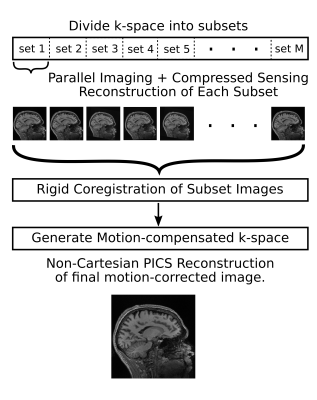 |
 Robust rigid-body motion estimation from extremely short subsets of 3D Cartesian scans Robust rigid-body motion estimation from extremely short subsets of 3D Cartesian scans
Gregory Lee
In this work, the ability to accurately co-register 3D volumes reconstructed from subsets of a variable-density 3D Cartesian acquisition is shown. Accurate rigid-body motion correction was possible for undersampling factors as high as a factor of 125 in a brain imaging application employing a 32-channel head coil. This enables efficient retrospective motion correction without loss of scan efficiency and without the need for any specialized MR hardware. This approach may help reduce the incidence of failed scans due to motion, potentially leading to a reduction for the need for sedation in pediatric patients.
|
14:15
|
1172.
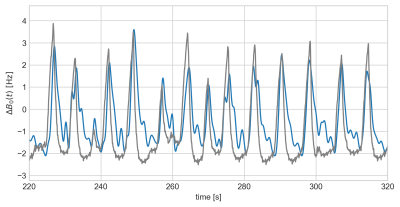 |
 Data-Driven Correction of B0-off-resonance fluctuations in gradient-echo MRI Data-Driven Correction of B0-off-resonance fluctuations in gradient-echo MRI
Jakob Meineke, Tim Nielsen
B0-off-resonance fluctuations can lead to artifacts in gradient-echo MRI with long echo-times. This work presents a purely data-driven method to estimate and correct for any B0-off-resonance fluctuation occurring during scanning, without additional data acquisition, navigator or image-processing. The estimated B0-off-resonance fluctuations are shown to be highly correlated with the signal from a respiratory bellows, the spatial variation of the fluctuations can be determined by exploiting the spatially varying coil sensitivities and histograms of R2* measurements show reduced variance.
|
14:27
|
1173.
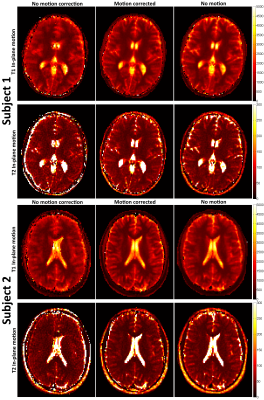 |
 Rigid motion corrected low rank magnetic resonance fingerprinting Rigid motion corrected low rank magnetic resonance fingerprinting
Gastao Cruz, Olivier Jaubert, Shaihan Malik, Torben Schneider, René Botnar, Claudia Prieto
Magnetic Resonance Fingerprinting (MRF) is a novel transient state relaxometry method that simultaneously estimates multiple quantitative tissue parameters. Motion occurring during the MRF acquisition can propagate errors into the parametric maps. Here we propose a novel motion corrected low rank method (MC-MRF) to simultaneously correct for rigid body motion and accelerate the scan. We investigated MC-MRF to correct for 2D in-plane motion on standardized phantom and in-vivo acquisitions. Additionally, we investigated the effect of through-plane motion in 2D MRF. Successful motion correction is achieved with MC-MRF for in-plane motion. Residual artefacts remain from through-plane motion after 2D retrospective motion correction.
|
14:39
|
1174.
 |
 Motion Correction in MRI using Deep Convolutional Neural Network Motion Correction in MRI using Deep Convolutional Neural Network
Kamlesh Pawar, Zhaolin Chen, N Shah, Gary Egan
Patient motion during MR data acquisition appears in the reconstructed image as blurring and incoherent artefacts. In this work, we present a novel deep learning encoder-decoder convolutional neural network (CNN) that recasts the problem of motion correction into an artefact reduction problem. A CNN was designed and trained on simulated motion corrupted images that learned to remove the motion artefact. The motion compensated image reconstruction was transformed into quantized pixel classification, where each pixel in the motion corrupted MR image was classified to its uncorrupted quantized value using a trained deep learning encoder-decoder CNN.
|
14:51
|
1175.
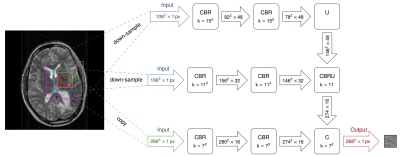 |
 Correction of motion artifacts using a multi-resolution fully convolutional neural network Correction of motion artifacts using a multi-resolution fully convolutional neural network
Karsten Sommer, Tom Brosch, Rafael Wiemker, Tim Harder, Axel Saalbach, Christopher Hall, Jalal Andre
Motion artifacts are a frequent source of image degradation in clinical practice. Here we demonstrate the feasibility of correcting motion artifacts in magnitude-only MR images using a multi-resolution fully convolutional neural network. Training and testing datasets were generated using artificially created artifacts introduced onto in vivo clinical brain scans. Both the corrupted input and filtered output images were rated by an experienced neuroradiologist.
|
15:03
|
1176.
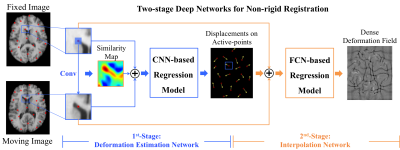 |
 Non-rigid Brain MRI Registration Using Two-stage Deep Perceptive Networks Non-rigid Brain MRI Registration Using Two-stage Deep Perceptive Networks
Xiaohuan Cao, Jianhua Yang, Li Wang, Qian Wang, Dinggang Shen
Non-rigid image registration is a fundamental procedure for the quantitative analysis of brain images. The goal of non-rigid registration is to obtain the smooth deformation field that can build anatomical correspondences among two or more images. Conventional non-rigid registration methods require iterative optimization with careful parameter tuning, which is less flexible when dealing with the diverse data. Therefore, we propose a two-stage deep network to directly estimate the deformation field between an arbitrary pair of images. This method can tackle various registration tasks, and is consistently accurate and robust without parameter tuning. Thus, it is applicable to clinical applications.
|
|












